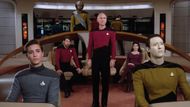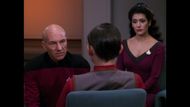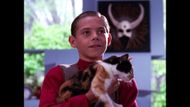Within the sprawling universe of Star Trek: The Next Generation, filled with cosmic diplomacy, philosophical dilemmas, and alien worlds, it’s easy to overlook the smaller, more intimate stories, the ones that don’t involve space battles or high-stakes negotiations but manage, in just a few quiet scenes, to speak volumes. The story of Jeremy Aster is one of those. He appears only once, in an episode called The Bonding, and yet his presence leaves a lasting emotional echo.
So, what became of this young boy aboard the Enterprise? And why, all these years later, are Star Trek fans still thinking about him? Here's what we know.
A quiet loss in a loud galaxy
In season three of The Next Generation, the episode The Bonding brings the audience into a deeply human experience: the death of a parent. Not in the abstract, but in the form of a boy, Jeremy, whose mother, Lieutenant Marla Aster, dies during an away mission on a planet littered with remnants of a long-past war. An old mine, a split-second misstep, and she’s gone.
News of her death returns to the Enterprise, where Jeremy, just twelve years old, waits unaware. And then it arrives. Not with melodrama or sweeping music, but with the stillness of someone receiving a truth too heavy for words. Gabriel Damon, the young actor who plays Jeremy, delivers a performance stripped of exaggeration, he looks like a child trying to keep his world from collapsing. It’s raw, and it's real.

Who was Jeremy Aster?
A civilian on the Enterprise, Jeremy lived with his mother, a Starfleet archaeologist. His father had died years earlier, which means that by the time The Bonding begins, Jeremy is already familiar with loss. But losing a parent to illness is one thing; having a mother taken by a hidden remnant of war, in a job that’s supposed to explore and protect, is something else entirely.
One of the crew most affected by Marla's death is Lieutenant Worf, the Klingon security officer who led the mission. Though not directly responsible, he feels the weight of her loss as a personal failure. Worf, raised by humans but steeped in Klingon honor, seeks a way to restore meaning to the pain. He approaches Jeremy not with consolation, but with R’uustai, a Klingon ritual that would make the boy his brother, bound by honor and memory. It’s an extraordinary offer. For Worf, it means vulnerability. For Jeremy, it means belonging.

Star Trek and the stories between the stars
Star Trek has always been a show about exploration, not just of space, but of what it means to be human in a universe that’s constantly changing. From the original series in the 1960s, through the layered diplomacy of Star Trek: The Next Generation, to the raw emotion of Deep Space Nine, the franchise rarely shied away from questions of identity, loss, and moral complexity.
Set aboard the USS Enterprise-D, The Next Generation introduced a new kind of crew: calm, cerebral, idealistic. Led by the ever-composed Captain Jean-Luc Picard, the team also includes Commander Riker, Data, Counselor Troi, and of course, Worf, each representing different facets of sentient experience.
In this landscape, Jeremy’s story is a quiet thread, but it tugs at something central. He reminds us that behind every mission log, there are people, children, families, who absorb the ripple effects of Starfleet’s choices. He is the emotional counterpoint to the exploration fantasy, and in just one episode, he embodies what’s at stake when things go wrong.

The mother who wasn’t
Not long after Marla’s death, something strange happens. An alien energy being, native to the war-ravaged planet below, materializes on the ship, taking the form of Jeremy’s mother. It doesn’t attack or manipulate; it simply wants to spare the boy his grief. It offers him a new life, one without sorrow, down on the surface where it can recreate everything he’s lost.
The temptation is understandable. Who wouldn’t want to step back into the arms of a parent, even if it’s an illusion? But Star Trek has always leaned toward emotional honesty, even when it hurts. As Counselor Troi and Captain Picard gently guide Jeremy through the reality of loss, the episode slowly dismantles the fantasy. Jeremy makes his choice, not without pain, but with clarity. He lets go. And he accepts Worf’s offer, taking part in the ritual that makes them brothers, not by blood, but by shared grief and chosen connection.

And then… what?
After The Bonding, Jeremy disappears from Star Trek: The Next Generation. He doesn’t show up in future episodes, nor is he mentioned again in the canonical series. But his story doesn’t end there, at least, not for fans.
In the Star Trek extended universe, novels and comics that expand the timeline beyond television, Jeremy finds new life. In books like Diplomatic Implausibility and Genesis Force, he’s depicted as a young adult who, like his mother, becomes an archaeologist. He stays in contact with Worf and continues to honor the Klingon bond they forged. In some storylines, he’s even accepted into the prestigious House of Martok, elevating his standing in Klingon society and embracing a dual identity that reflects both his human upbringing and his warrior ties.
There’s also the comic The Lesson, which revisits Jeremy in adolescence. The story doesn’t paint him as a perfect hero, but as a real teen, struggling with loyalty, conflict, and what it means to grow up with a Klingon as family.
None of these continuations are considered canon, but they speak to the impact his character had. You don’t get that kind of afterlife unless people cared.

Why his story matters
In a franchise with dozens of starships, space stations, and alien species, it might seem surprising that fans would hold on to the memory of one quiet boy. But Star Trek has always understood that sometimes, the smallest stories carry the most weight.
Jeremy Aster’s arc touches on what happens between the battles and diplomatic breakthroughs. It asks what’s left behind when the mission ends and the crew goes home. It reminds viewers that every redshirt who dies has someone waiting, someone who carries the grief forward. His story makes the universe feel real.
It also deepens Worf. His choice to bond with Jeremy shows a tender, compassionate side that runs underneath the warrior exterior. And that tenderness, explored more in his relationships with his son Alexander, with Jadzia Dax, and with the crew, begins here. With a boy. And a promise.

How it was received
When The Bonding aired, it was praised for its emotional restraint and depth. Critics highlighted the writing, the first by Ronald D. Moore, who would go on to shape Battlestar Galactica and transform modern sci-fi storytelling. His voice, full of moral nuance and character-driven moments, made its debut with Jeremy’s story.
The episode also helped set the tone for The Next Generation’s maturity. It showed that the show wasn’t afraid of introspection, that it could pause from its weekly adventures to sit with something as human and messy as loss.

A name, a gesture, a memory
Jeremy Aster isn’t a major player in the Star Trek timeline. He doesn’t go on grand missions, command starships, or uncover galactic secrets. But his story stays with us. Because it reminds us that pain doesn’t care about rank. That love sometimes comes from the places we least expect. That family can be chosen, forged not in genetics, but in shared sorrow and honor.
And maybe that’s what Star Trek is really about. Not just exploring the stars, but exploring who we become when the stars go dark. Jeremy Aster helped show us that. And even in his silence afterward, his presence is still felt, like a quiet gravity, always there.
